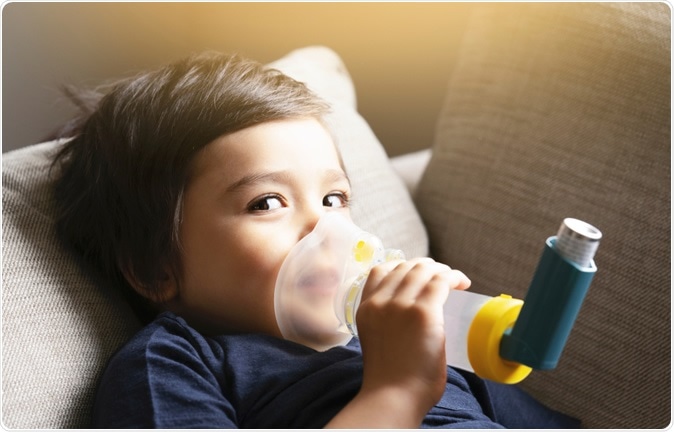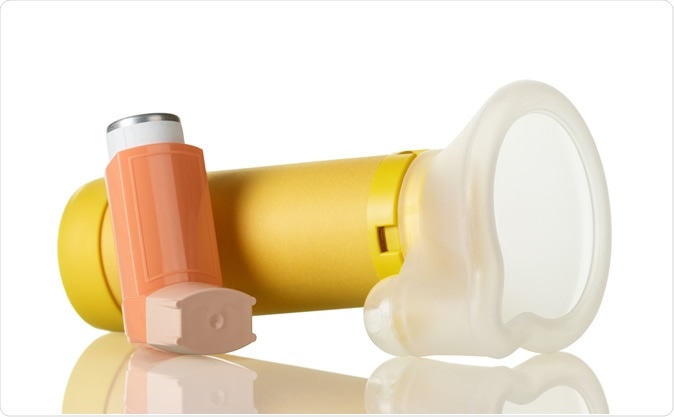Children with mild asthma may use two inhalers – one steroid and the other a bronchodilator, when symptoms occur, a new study shows.
A team of researchers at the Washington University School of Medicine has found that kids with mild asthma may effectively manage their symptoms with inhalers. In the past, doctors will prescribe monthly steroid maintenance drugs even if there were no symptoms present.
The use of as-needed inhalers has the same efficacy for mild asthma as the conventional practice, the study published in the Journal of Allergy and Clinical Immunology: In Practice, suggests. The steroid inhaler works by reducing inflammation while the bronchodilator is a rescue inhaler, which helps by relaxing the airway at the event of an asthma attack. These inhalers both work by making the child breathe easier and better.

Image Credit: Ann in the uk / Shutterstock
As-needed treatment vs. maintenance treatment
To arrive at their findings, the researchers conducted a randomized, open-label, pragmatic equivalence trial in African-American children between the ages of 6 and 17 years old, who have mild asthma. The study enrolled on African-American children who are more affected by asthma.
A total of 12 primary care providers handled 206 children to see the effect of either a symptom-based adjustment (SBA) of inhaled corticosteroids, with beclomethasone 80 μg with short-acting rescue β-agonist or provider-based guideline-directed adjustment (PBA), which included a maintenance steroid.
All the participants were given symptom recognition and albuterol use education, and they were observed for over 12 months.

Pictured is a typical inhaler (orange) and spacer (yellow) for treating asthma in children. Image Credit: Laboko / Shutterstock
Same effect, less medication
By the end of the one-year-research, the investigators found no differences between the two groups. The two groups managed their asthmas symptoms and performed well in breathing tests to measure lung function.
The team also found that the as-needed approach decreased the number of steroids the children consumed monthly by as much as 75 percent.
"Patients in the group that used both inhalers as needed used about one-fourth the steroid dose of the group that inhaled a prescribed daily amount. We also were pleased to see that the patients and families felt that they had more ownership over their asthma management when practicing as-needed treatment," Kaharu Sumino, Associate Professor at the Washington University, said in a statement.
Furthermore, the group that took daily doses used more of steroids per month than those in the symptom-based group. In total, the children in the group who took daily doses consumed 1,961 micrograms per month. On the other hand, the SBE group only used 526 micrograms per month, with the same results. The researchers also noted that prolonged use of steroids among children might have side effects such as stunted growth.
“Many families are concerned about the cost of this medication as well as the growth-related side effects and stop taking their steroid medicine altogether. So, it’s nice to show that less medication — used as needed — is just as effective,” Sumino explained.
“This as-needed steroid plus rescue albuterol strategy is now recommended in the Global Initiative for Asthma guidelines as one of the options for the treatment of mild asthma. Given the result of our study and others, primary care doctors may tell their patients with mild asthma that they have an alternative effective strategy other than taking the inhaled steroid every day if they prefer not to do so,” she added.
Bronchial asthma is a major problem across the globe
Asthma is one of the major non-communicable diseases worldwide, according to the World Health Organization (WHO). About 235 million people currently suffer from bronchial asthma, and in 2015, there were 383,000 deaths due to asthma.
In the United States, about 6.2 million children below 18 years old are living with asthma. African-American children are more affected than white children. In white children, 7.4 percent have asthma, while in African-American children, the number nearly doubles to 13.4 percent.
The Asthma and Allergy Foundation of America reports that asthma accounts for 9.8 million doctor’s office visits and 1.8 million emergency department visits each year. In children younger than 15, asthma ranks third as the major cause of hospitalization.
What happens in asthma?
Asthma is a disease affecting the lungs, characterized by recurrent attacks of wheezing, breathlessness, nighttime or early morning coughing, and chest tightness. It can occur several times day or week. During an asthma bout, the bronchial tubes swell, leading to narrowed airways and reduced airflow into the lungs.
Source:
Journal reference:
Sumino, K., Bacharier, L., Taylor, J., Chadwick-Mansker, K., Curtis, V., Nash, A., Jackson-Triggs, S. Moen, J., Schechtman, K., Garbutt, J., and Castro, M. (2019). A Pragmatic Trial of Symptom-Based Inhaled Corticosteroid Use in African-American Children with Mild Asthma. Journal of Allergy and Clinical Immunology: In Practice. https://www.sciencedirect.com/science/article/pii/S2213219819306026